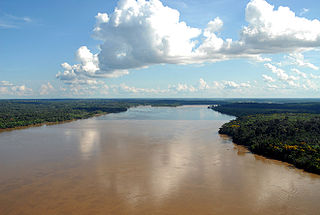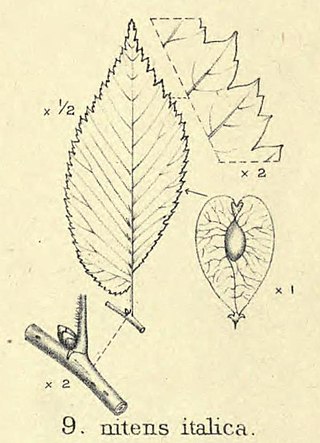
The Madeira River is a major waterway in South America. It is estimated to be 1,450 km (900 mi) in length, while the Madeira-Mamoré is estimated near 3,250 km (2,020 mi) or 3,380 km (2,100 mi) in length depending on the measuring party and their methods. The Madeira is the biggest tributary of the Amazon, accounting for about 15% of the water in the basin. A map from Emanuel Bowen in 1747, held by the David Rumsey Map Collection, refers to the Madeira by the pre-colonial, indigenous name Cuyari.
The River of Cuyari, called by the Portuguese Madeira or the Wood River, is formed by two great rivers, which join near its mouth. It was by this River, that the Nation of Topinambes passed into the River Amazon.

The Polygonaceae are a family of flowering plants known informally as the knotweed family or smartweed—buckwheat family in the United States. The name is based on the genus Polygonum, and was first used by Antoine Laurent de Jussieu in 1789 in his book, Genera Plantarum. The name may refer to the many swollen nodes the stems of some species have, being derived from Greek [poly meaning 'many' and gony meaning 'knee' or 'joint']. Alternatively, it may have a different origin, meaning 'many seeds'.

Meryta sinclairii, the puka or pukanui, is a large-leaved evergreen tree endemic to New Zealand that grows to about 8 m tall, with the distinctly tropical appearance typical of the genus. There are about 27 species of Meryta, all small, resinous trees of the subtropical and tropical Pacific Ocean.

Rondônia is one of the 26 states of Brazil, located in the northern subdivision of the country. It is bordered by Acre in the west, Amazonas in the north, Mato Grosso in the east, and Bolivia in the south. Rondônia has a population of 1,815,000 as of 2021. It is the fifth least populated state. Its capital and largest city is Porto Velho, bathed by the Madeira River. The state was named after Cândido Rondon, who explored the north of the country during the 1910s. The state, which is home to c. 0.7% of the Brazilian population, is responsible for c. 0.3% of the Brazilian GDP.

Coccoloba is a genus of about 120–150 species of flowering plants in the family Polygonaceae, which is native to the Neotropics. There is no overall English name for the genus, although many of the individual species have widely used common names.

Coccoloba uvifera is a species of tree and flowering plant in the buckwheat family, Polygonaceae, that is native to coastal beaches throughout tropical America and the Caribbean, including central & southern Florida, the Bahamas, the Greater and Lesser Antilles, and Bermuda. Common names include seagrape and baygrape.

Cotinus, the smoketree or smoke bush, is a genus of seven species of flowering plants in the family Anacardiaceae, closely related to the sumacs (Rhus).

Ulmus microcarpa was named and first described by the Chinese botanist L. K. Fu, who discovered the tree in the Chayu broad-leaved forests of south-eastern Xizang at altitudes of around 2800 m during the 1973 Qinghai - Tibet Expedition. Unlike the majority of Tibet, the Chayu region has a subtropical highland climate featuring warm, wet, summers and mild, dry, winters. Commonly known as the Tibetan Elm, the tree was introduced to the United States in 2006, and the UK in 2013; it remains one of the rarest species of elm in cultivation.
The Amazonian hocicudo is a species of rodent in the family Cricetidae from South America. It is found in the Amazon basin in Brazil where it lives in moist lowland forest. It is a common species with a large range and is rated by the IUCN as being of "least concern".
The hybrid elm cultivar Ulmus × hollandica 'Modiolina', or Wheel-hub elm, was probably the large-leaved 'Orme tortillard' first described by Duhamel in De l'exploitation des bois (1764). Poederlé (1774) identified the tree as the 'orme maigre' growing in the region that later became part of Belgium. Dumont de Courset described a small-leaved U. campestris var. modiolina, "l'orme tortillard" in 1802 – the first use of the name 'Modiolina'. 'L'orme Tortillard', also known as 'l'orme à moyeux', was considered in France to be the best elm for use by wheelwrights, its timber especially suitable for hubs of wheels. Van Houtte marketed an U. campestris modiolina (tortuosa), and Späth an U. campestris modiolina, from the late 19th century. U. campestris var. modiolinaHort was confirmed as a hybrid by Chevalier in Les Ormes de France (1942) and called U. × 'Modiolina', 'l'orme à moyeux'.

The Rondonia bushbird is a Near Threatened species of bird in subfamily Thamnophilinae of family Thamnophilidae, the "typical antbirds". It is endemic to Brazil.

Aphandra is a monotypic genus of flowering plants in the palm family native to the Amazon rainforest vegetation in South America. Its only species is Aphandra natalia, sometimes called mastodon palm or fiber palm, and is used by indigenous peoples in the construction of brooms and other products. This plant is commercially exploited for its edible fruits, and for its leaf sheath and petiole fibers. This fiber is almost equal to the fiber extracted from Attalea funifera and Leopoldinia piassaba, which is called piassava.
Ulmus boissieriGrudz.,, a disputed species of elm found in Iran, was identified by Grudzinskaya in 1977. She equated her "new species" with the U. campestris f. microphylla collected in 1859 in Kerman Province and described in his Flora Orientalis (1879) by Boissier, for whom she named it, treating Boissier's specimen as the "type". The tree is endemic the provinces of Kermanshah and Kerman., and also the Zagros forests, growing with Quercus brantii, Celtis australis, Platanus orientalis, Fraxinus sp., and Cerasus mahaleb.
The Samuel Ecological Station is a strictly protected ecological station in the state of Rondônia, Brazil. It contains a tract of Amazon rainforest that extends east from the reservoir formed by the Samuel Hydroelectric Dam.
The Jacundá National Forest is a sustainable-use national forest in the state of Rondônia, Brazil.
Corymbia lamprophylla, commonly known as shiny-leaved bloodwood, is a species of tree that is endemic to central Queensland. It has rough, tessellated bark on the trunk and larger branches, lance-shaped adult leaves, flower buds in groups of seven, creamy white flowers and urn-shaped fruit.

Eucalyptus virens, commonly known as the shiny-leaved ironbark, is a species of small to medium-sized tree that is endemic to Queensland. It has hard ironbark on the trunk and branches, narrow lance-shaped adult leaves, flower buds in groups of seven, white flowers and hemispherical fruit.

Ulmus minorvar.italica was first described by Augustine Henry in 1913, as a 'variety' of field elm from Italy, Spain, Portugal and Algeria. He called it Ulmus nitens var. italica, 'Mediterranean Elm'. The variety was accepted by Krüssman (1984), despite the wide source-area claimed for it, as a non-clonal cultivar, U. carpinifolia var. italicaHenry. Bean (1988), however, considered it "a variety of rather dubious standing", and it was ignored by Richens (1983), who listed instead a "small-leaved U. minor of Spain" and a "narrow-leaved U. minor of northern and central Italy", as well as "the densely hairy leaved U. minor of southern Italy", the latter being Ulmus minor subsp. canescens, formerly Melville's Ulmus canescens.

Tyttocharax madeirae, the blackedge tetra, also known as the bristly-mouthed tetra or the blue tetra, is a small freshwater fish of the family Characidae found in the Amazon basin of South America. It was first caught by Edgar A. Smith in 1912 in Brazil and described by American ichthyologist Henry Weed Fowler in 1913.














